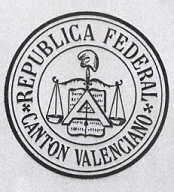This article needs additional citations for verification .(June 2025) |
Cantonalism (Spanish : cantonalismo), mainly prevalent in the late 19th century and early 20th century Spain, is a political option which aims to divide the state into highly autonomous cantons.
Contents
It advocates federalism with a radical character (including redistribution of wealth, improvement of the working classes etc.). Its goal is to establish a confederation of independent towns or cities (cantons). It has a resemblance in some ways to the Greek polis, due to both being systems of individual towns or cities, ruled by citizens, which make up the overall confederacy. Cantonalism was predominantly a phenomenon of the petty bourgeoisie, but also had a great influence on the nascent labor movement, and constituted a precedent for anarchism in Spain.[ citation needed ]
